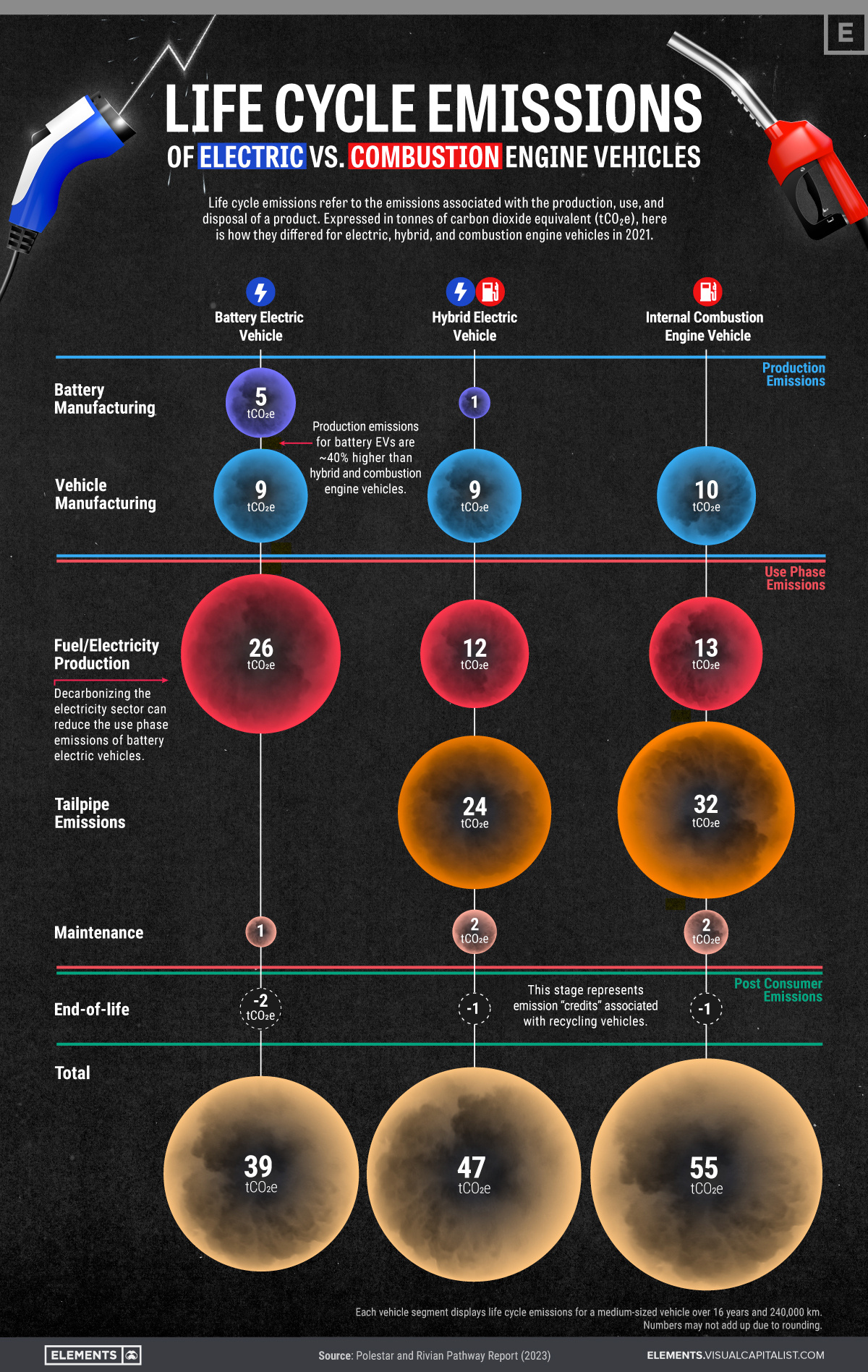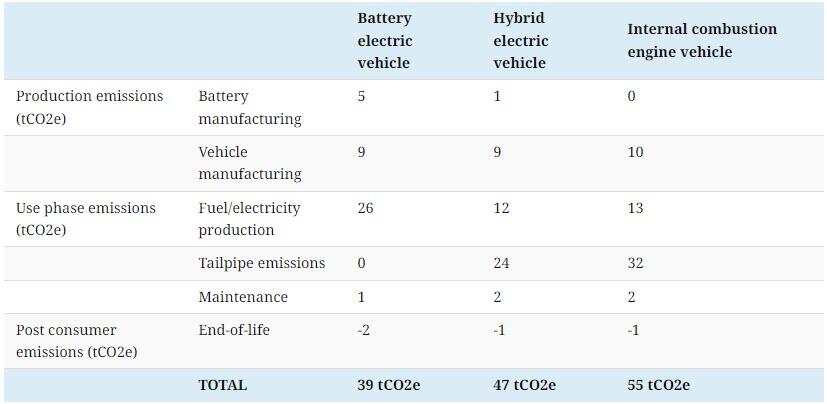
Posted on 07/03/2023 9:10:50 PM PDT by SeekAndFind

According to the International Energy Agency, the transportation sector is more reliant on fossil fuels than any other sector in the economy. In 2021, it accounted for 37% of all CO2 emissions from end‐use sectors.
To gain insights into how different vehicle types contribute to these emissions, the above graphic visualizes the life cycle emissions of battery electric, hybrid, and internal combustion engine (ICE) vehicles using Polestar and Rivian’s Pathway Report.
Life cycle emissions are the total amount of greenhouse gases emitted throughout a product’s existence, including its production, use, and disposal.
To compare these emissions effectively, a standardized unit called metric tons of CO2 equivalent (tCO2e) is used, which accounts for different types of greenhouse gases and their global warming potential.
Here is an overview of the 2021 life cycle emissions of medium-sized electric, hybrid and ICE vehicles in each stage of their life cycles, using tCO2e. These numbers consider a use phase of 16 years and a distance of 240,000 km.

While it may not be surprising that battery electric vehicles (BEVs) have the lowest life cycle emissions of the three vehicle segments, we can also take some other insights from the data that may not be as obvious at first.
As we move toward a carbon-neutral economy, battery electric vehicles can play an important role in reducing global CO2 emissions.
Despite their lack of tailpipe emissions, however, it’s good to note that many stages of a BEV’s life cycle are still quite emission-intensive, specifically when it comes to manufacturing and electricity production.
Advancing the sustainability of battery production and fostering the adoption of clean energy sources can, therefore, aid in lowering the emissions of BEVs even further, leading to increased environmental stewardship in the transportation sector.
I wonder how a hydrogen strategy would compare….
Does this include a factor in mining of the various ingredients if you will? I have always figured at the end of the day these cars will be about the same impact. I’m on one hybrid, no electrics, lots of gas over the years. I love the hybrid for the 60 miles a gallon, but I sure love the gas for power. I could not imagine buying an electric car and being dependent upon availability of electricity to recharge, especially living out in the rural area like Nevada.
Hydrogen, I still don’t understand why we haven’t seen that as an alternative fuel.
RE: Does this include a factor in mining of the various ingredients if you will? I
I don’t see that on the chart, NO.
The chart starts at the manufacturing phase, not the mining for raw materials phase.
One more time. C02 is PLANT FOOD. Those that produce the most C02 should receive AWARDS for the real greening of the Earth.
Instead of sequestering C02, we should sequester the envirowackos, all on the same island, with plenty of bugs to eat (until the bugs eventually eat them)
Expense to make and contain. Never mind reactivity. Also, hydrogen has far less energy than other gases, e.g. 30 percent of the energy content of methane for the same volume.
Difference is small and more importantly, CO2 is not a problem.
Air pollution/smog is a thing, but that’s not CO2.
Take note of who produced that life cycle graphic...
“Polestar and Rivian Pathway Report”
Two EV manufacturers.
“Hydrogen, I still don’t understand why we haven’t seen that as an alternative fuel.”
Hydrogen is not a fuel. It is another type of battery. It only stores energy that is produced elsewhere.
Since these EV’s, because of the weight of the battery, are significantly heavier than gas-powered vehicles, they will wear down road surfaces faster. They will also require more tire replacements. For instance, electric models from Ford, Volvo and Toyota were all roughly 33 per cent heavier than the gas-powered versions of the same vehicles. Increased road repairs require massive energy to transport road materials, equipment, labor and the fuels to run the repair equipment. This cost of repair will mean more dollars out of our pockets in taxes.
The carbon Chicken Littles are too worried about the sky falling than to concern themselves with the factual consequences of their chicken-brained illusions.
“The chart starts at the manufacturing phase, not the mining for raw materials phase.”
It also conveniently ignores the gigantic expansion of the electric grid needed for renewables. It assumes that today’s electrical grid will suffice. A report last week said we would have to add 50,000 miles of transmission lines to handle “green” power. It took EIGHTEEN YEARS to get the permits for ONE 750 mile line from Montana to California.
It also ignores the enormous costs of remediating wind power sites when the turbines reach the end of the economic life.
It also ignores the fact that the secondary electrical distribution system (the power lines in your neighborhood and associated transformers) can, today, handle the charging of three, maybe four EVs at night. You need to rebuild the entire secondary distribution system.
It ignores the large amount of water required to wash dust off solar panels, water that is scarce or non-existent in desert locations. There was an article a day or two ago about a California town running out off water after a solar farm was built nearby.
It ignores the fact that you need a conventional backup plant for the hours the wind doesn’t blow and the sun doesn’t shine.
It ignores the fact that the Capacity Factor of renewables is usually less than 30% (Capacity Factor is annual output divided by nameplate output over a year). These are horrendous investments. Nobody would invest in an asset that has such low CF unless the government was there to subsidize it.
Were all these things honestly taken account of, they’d find that the EV is an ecological disaster compared to ICE.
Ah but wind and solar last forever and we have only 400-500 years of oil in the US. /s
One looks at “facts” prepared by the battery vehicle cheerleading squad and wonders just how factual they really are.
Because pure hydrogen is extremely flammable, extremely reactive, and takes more energy to separate from its bound state in molecules than it could ever provide to power anything.
Anyone can make a pretty graph with whatever numbers they want and it doesn’t make it true.
I’ve always said a hybrid was the logical first step. A 40% reduction in fuel usage and easy to convert current car production. That would buy the time to ramp up production of the rare materials used in EVs.
My guess is that the hybrid car would win in per capita miles driven because the EV wouldn't be driven as many miles due to distance between recharge and recharge rate limitations.
The hybrid can be driven for longer distances on the same tank of gas than a solo internal combustion engine car, so the emissions would be spread out over more miles driven.
I've driven across the country in an ICE car several times and half-way across the country in a hybrid. I can't imagine doing that in an EV at all.
-PJ
The assumption is clean generation of electricity. The grid is only 33% efficient, and nuclear has gone the way of the dinosaur. I don’t trust thus stuff, the devil is always in the details.
Disclaimer: Opinions posted on Free Republic are those of the individual posters and do not necessarily represent the opinion of Free Republic or its management. All materials posted herein are protected by copyright law and the exemption for fair use of copyrighted works.